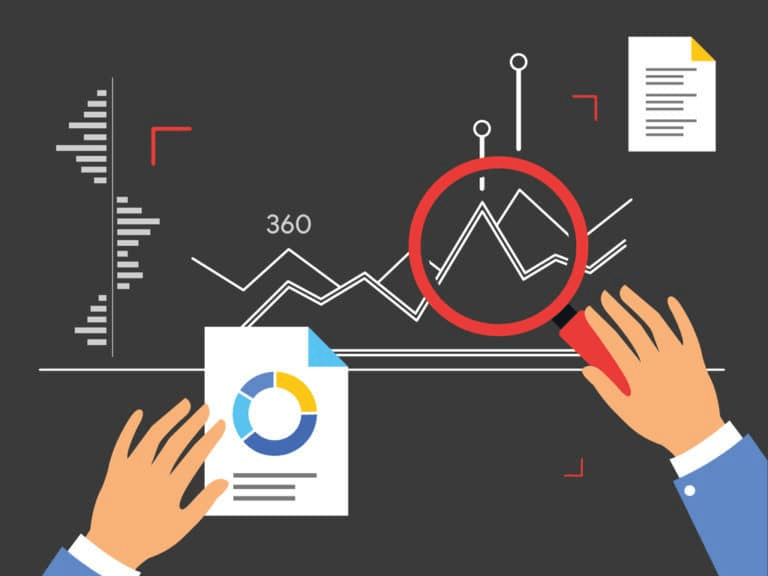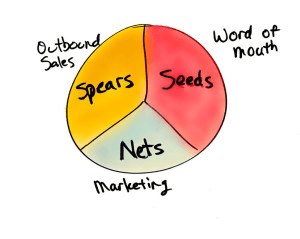Sales forecasting isn’t the sexiest subject in lead generation, is it?
Exciting sales tactics and strategies often earn that glamorous title. But guess what?
Failing to accurately predict revenue is costing you revenue.
This is because sales forecasts influence the decisions and actions of everyone - from the c-suite to execution level - involved in or remotely connected to the sales process:
Directors use them to predict expenses, revenue, and allocate budgets
Managers rely on them to set quotas for sales reps
Sales reps use them to plan and prioritize lead generation efforts
Ahead, I’ll show you how to forecast sales and predict revenue without migraine-inducing algorithms and complex formulas.
Note: Want to use reliable data, pipeline status, and trends to accurately forecast sales? Sign up for Leadfeeder's 14-day trial.
Why you need to forecast sales

Sales forecasts alert you to issues and threats so you can avoid or mitigate them.
For example, if you discover that your team is 30 percent below quota, you can diagnose the cause and correct course before you fall too far behind.
Maybe you discover that a competitor is aggressively undercutting your product, or a newly launched sales rep reward program isn’t performing as well as it should.
Whatever the cause is, you can spot the downward trend early and prevent further damage.
This foresight also plays a big role in strategic decisions like:
Sales plans
Budget management
Hiring and resources
Individual sales quotas
Corporate revenue/sales targets
Sure, it’s not the most thrilling way to spend your Monday morning. But projecting sales revenue transcends pleasing accountants or giving executives a fancy spreadsheet.
It helps you create a proactive sales strategy. One that weathers economic downturns, seasonal spikes, and counters competitors who are hungry for your market share.
How to forecast sales: the predictable revenue approach
When Aaron Ross drove Salesforce to $100 million in sales, he did so without traditional cold calling and without raising the sales team’s headcount.
How did he do this?
Aaron used the trademark approach detailed in his book, Predictable Revenue. This is a sales forecasting technique that consistently projects year-over-year revenue.
It eliminates the reactive, last-minute panic that most befalls sales teams by the end of each month or quarter.
And most importantly, it helps build a sales machine that consistently generates high-quality leads.
Here’s how you can use the Predictive Revenue approach to forecast sales and create own your own sales machine:
1. Assort and score leads by these three categories
Not all leads are created equal.
Certain leads will convert better than others, have different conversion rates, and follow their own unique path when moving through your sales funnel.
So before you attempt to forecast sales and take any proactive or reactive measures, you’ve got to categorize leads - and their respective sales paths - to better understand them.
Aaron advises labeling these leads as seeds, nets, and spears.

Seeds: These are leads referred to you from other customers. While these word-of-mouth leads are ideal, your options for increasing them are limited
Growing your number of “seed” leads is about delivering exceptional customer experience. This is why here at Leadfeeder, we focus on retention over churn and champion our customer success team
Nets: Attracted by marketing through advertising or content, “net” leads are best increased through inbound lead generation
Spears: Captured by sales via targeted prospecting, “spear” leads are best grown through a dedicated outbound sales team of prospectors
2. Set the stages of your sales cycle
The next essential step is to define the stages leads will move through, and how they’ll advance through the pipeline.
For example, the stages of your sales cycle might include:
Prospecting
Qualification
Proposal
Closing
Defining and agreeing on the sales cycle you’ll use in your CRM means all reps are on the same page. It also allows you to define the issues that crop up during sales forecasts.
If there are 25 percent fewer leads moving from the prospecting to qualification stage, for instance, this indicates potential issues with lead qualification or targeting.
3. Encourage all reps to update CRM data
CRM data include attributes like company size, industry, number of employees, and location.
It’s also the hub for tracking deal and pipeline history - two key ingredients for any sales forecast.
Unfortunately, populating answer fields in a CRM might feel like a trivial burden to some sales reps, but accurate CRM data and useful sales forecasts go hand in hand.
This record of past performance is non-negotiable. To ensure all reps fill out CRM data:
Educate sales reps with examples of good and poor CRM data hygiene
Create alerts to draw attention to lazy or bad practices
Tie the accuracy of CRM data to KPIs
4. Use the right sales forecasting technique

After categorizing your leads, setting the stages of your sales funnel, and making sure you have a solid foundation of accurate CRM data, you’re ready to start forecasting.
But, what’s the right sales forecasting method for you?
That depends on your sales funnel, pipeline build, and forecasting goals.
To guide you to the right method, here’s a breakdown of the main sales forecasting techniques and when (and why) you should (or shouldn’t) use them:
Length of sales cycle forecasting
Forecasting using the length of your sales cycle helps you predict the probability of a deal closing.
It’s a great way to objectively gauge different deals in your pipeline, but it demands accurate CRM data and can prove tricky if you have longer sales cycles.
To get accurate results, you'll need to monitor how and when leads enter your pipeline. You’ll also need to ensure that your CRM integrates with your marketing software.
Opportunity stage sales forecasting
This sales forecasting method accounts for the stage of the sales process each deal is in.
The further along a given deal is in the pipeline, the more likely you’re to “win” it.
After you've specified the period of time you’ll be reporting - often a month, quarter, or year - multiply the potential value of each deal by the probability that it will close.
Once you’ve completed this exercise for each deal in your pipeline, you simply total them to get the final forecast amount.
While this method is an easy way to generate a sales forecast, it’s not the most accurate technique as it focuses on live deals and fails to include past sales performance.
Regression analysis sales forecasting
When it comes to forecasting sales, regression analysis is as formulaic as you can get.
For this method to work, you’ll need a good grasp of statistics and the factors that drive your company’s sales. You’ll also need to calculate the link between variables that impact sales.
Regression analysis generates incredibly accurate sales forecasts. Unfortunately, it’s also one of the most advanced forecasting techniques out there.
If you have the resources and expertise available to execute it, regression analysis will pay off.
Historical Sales Forecasting
Historical forecasting allows you to quickly predict sales and revenue by referring to a matching time period in the past.
It’s an ideal way to forecast sales if you’re in a stable market or just want to establish a benchmark for your forecast.
If you’re offering seasonal products or services, or are experiencing fluctuating demand, it’s best to avoid this method of projecting revenue.
The truth about forecasting sales
Sales forecasting might not be sexy, but it is super-effective for reviewing:
Where your revenue stands
What issues are plaguing your pipeline
And how you can boost sales
To be successful, you don’t need to be the Dali Lama of CRM data hygiene. And you don’t need to hold a Ph.D. in statistics.
But you do need to respect the value of accurately tracking leads and deal information.
This means uniting your marketing and sales teams under the shared goal of generating more leads together. See how Leadfeeder can help you do just that.
Note: Want to use reliable data, pipeline status, and trends to accurately forecast sales? Sign up for Leadfeeder's 14-day trial.
Now that you're here
Leadfeeder is a tool that shows you companies that visit your website. Leadfeeder generates new leads, offers insight on your customers and can help you increase your marketing ROI.
If you liked this blog post, you'll probably love Leadfeeder, too.
Sign up






